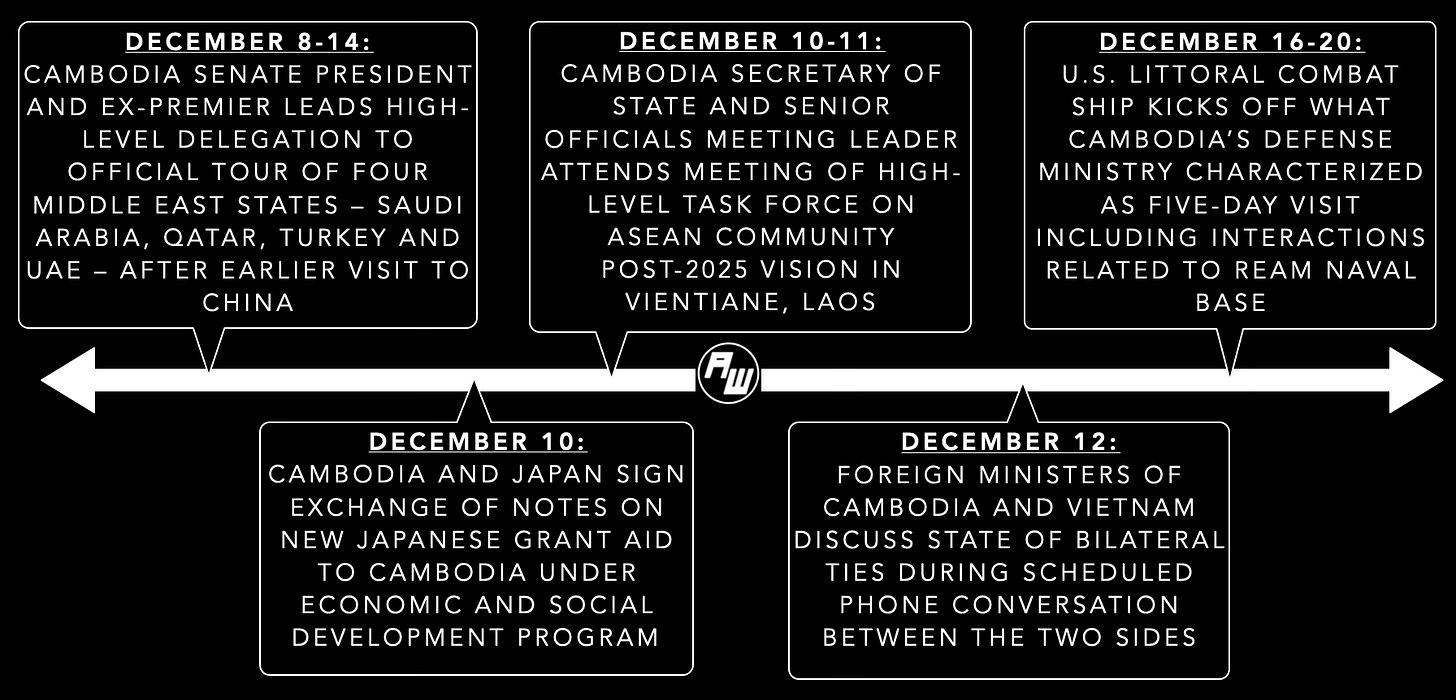Ream Naval Base Link Amid Cambodia Diversification Narrative
Plus minilateral lookahead; new AI hub; nuclear pact launch; chip war influx; coming Pacific deal; giant EV partnership; 2025 crisis outlook & much, much more.
Greetings to new readers and welcome all to the latest edition of the weekly ASEAN Wonk BulletBrief! If you haven’t already, you can upgrade to a paid subscription for $5 a month/$50 a year below to receive full posts by inserting your email address and then selecting an annual or monthly option. You can visit this page for more on pricing for institutions, groups as well as discounts. For current paid subscribers, please make sure you’re hitting the “view entire message” prompt if it comes up at the end of a post to see the full version.
For this iteration of ASEAN Wonk BulletBrief, we are looking at:
Assessing the geopolitical and geoeconomic significance of new naval base links amid diversification talk;
Mapping of regional developments, such as a minilateral lookahead; trade pact traction and new rail links;
Charting evolving geopolitical, geoeconomic and security trends such as new AI hub; nuclear pact launch and coming Pacific deal;
Tracking and analysis of industry developments and quantitative indicators including chip war influx; giant EV partnership; 2025 crisis outlook and more;
And much more! ICYMI, check out our latest ASEAN Wonk Podcast episode featuring a former U.S. ambassador on what Southeast Asia and ASEAN can expect from President Donald Trump’s return to the White House.
This Week’s WonkCount: 2,106 words (~9 minutes)
Minilateral Lookahead; Trade Pact Traction; New Rail Links & More

2025 Geoeconomic Risk Outlook; Regional Power Rankings & Connectivity Paradox
“While the assumed policy changes under the risk scenario primarily affect the US and the People's Republic of China (PRC), the magnitude of the impacts are rather modest and limited given the size of the policy changes, notably on tariffs,” argues the latest forecast released by the Asian Development Bank (ADB) that includes growth impacts under a so-called Trump presidency high-risk scenario. Southeast Asia’s own growth rate has revised up to 4.7 percent. But the ADB also noted that risks remain for the region as it heads into 2025, including inflationary pressures and severe weather events impacting specific sectors like agriculture and infrastructure (link).
GDP Growth Impacts Under the Trump Presidency High-Risk Scenario, 2025-2028
“The Philippines…for the first time has entered second place in the ranking, knocking mainland China down a slot,” according to the findings of a new Climatescope 2024 report released by Bloomberg NEF that includes a list of top 10 emerging markets in the power sector. The report also reinforces Asia’s key position globally across a series of metrics including energy certification and concentration of markets with auctions and feed-in tariffs (link).
Top 10 Emerging Markets in the Power Sector
“The paradox of the internet…has reached a critical moment” in Southeast Asia where the democratization of information has led to the distortion or facts and truth rather than the democratization of ideas, notes a new paper published over at Stanford University. The paper suggests several building blocks to resolve the aforementioned internet paradox across several areas including politics, education and the media (link).
Internet Use in Southeast Asia Since 1990 (By Country, Millions and % of Population)
Ream Naval Base Link Amid Cambodia Diversification Narrative
What’s Behind It
Cambodia’s government played up the arrival of a U.S. vessel amid growing concerns about the impact of China ties on its interests1. The Cambodian defense ministry’s original December 13 announcement that the visit would include meeting officials managing Ream naval base was itself not surprising to close observers: as ASEAN Wonk has noted previously, the Cambodian government has stepped up engagement of even non-government observers — including via briefings and curated site visits — to counter earlier U.S. claims that the base was providing a key access point for China2. But the announcement also gave room for some state media to frame the trip as, in the words of one account, “a chance to silence Ream base critics.”3 The hype occurred amid an active week for Cambodia’s defense and foreign relations. This included Japan’s quiet delivery of new patrol boats and a first-of-its-kind exercise with India (see graphic below and subsequent WonkDive sections)4.
Select Recent Foreign Policy and Defense Developments Involving Cambodia
Beyond the U.S.-China lens, the playing up of the development also spotlighted Cambodia’s wider diversification narrative amid suggestions that China overreliance is infringing on its own interests. That narrative has been replayed in recent months across interactions, including former premier and current senate president Hun Sen's four-country Middle East tour this past week and an agreement with Canada to open a new embassy in October5. The door to improving U.S. engagement has also been left open, and both countries continue interacting in some realms despite differences (apart from bilateral ties, Cambodia is also the current country coordinator for US-ASEAN dialogue relations until 2027). Notable examples in this regard include the visit of U.S. Defense Secretary Lloyd Austin to Cambodia in June, the holding of the first defense policy dialogue since 2019 and the trip made by USAID administrator Samantha Power during that same month — the first visit of its kind for that position6.
Why It Matters
The development also highlights key datapoints to watch in 2025 with respect to the major external partnerships that Cambodia has beyond China and the United States (see originally generated ASEAN Wonk table below on notable developments on areas to watch, select major datapoints and key domains. Paying subscribers can also read on for more on what to expect and future implications in the rest of the “Why It Matters” and “Where It’s Headed” sections, along with remaining paid-only sections of the newsletter as usual).











